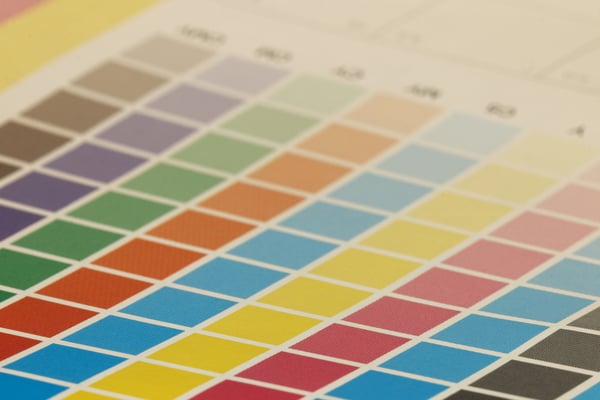Share this
Digital Flexo Printing: What Components Do You Need?
by Luminite on Jul 18, 2019 10:17:56 AM

If you're reading this article, you're probably already familiar with flexographic printing, printing that uses cylinders and elastomer sleeves to print on a variety of substrates at high speeds, while achieving high quality products.
But did you know there's a digital option for flexographic printing that uses sensors and automation to improve consistency and color accuracy, precisely reproducing any unique Pantone color from the extended gamut on every print run?
What Is Digital Flexo Printing?
Digital flexo printing automates the entire process of flexographic printing to help reduce lead time, cut machine stops, improve accuracy, and increase consistency.
Using digital sensors to automatically mix and measure colors while also adjusting the intake and outtake of substrate, registration, and pressure, digital flexo printing creates reproducible print jobs while reducing wasted ink, unused substrate, and machine time.
Digital flexo commonly utilizes a seven-color gamut that layers color to achieve the correct hue. Thanks to this feature, no colors have to be mixed. The ink and anilox rolls can often be left in press between print jobs, saving time and material.
Digital flexo printing also allows printers to queue multiple print jobs at a time. As the first print job finishes, the second job automatically runs without the need to stop the machine.
Additionally, some flexographic printers have opted to create hybrid analog-digital flexo systems by installing digital print stations on their existing analog printing presses.
What Components Do You Need for Digital Flexo Printing?
The initial investment into new equipment can be a deterrent for some printers, causing many flexographic printers to add retrofit digital systems to their existing presses. This easily allows printers to expand printing capabilities while using their existing equipment.
With CMYK and OGV color printing capabilities, existing flexographic printers can get the best of both worlds with the ability to run small print jobs using digital printing and their existing presses.
To outfit a hybrid analog-digital press, printers will need:
- Retrofitted digital system
- Anilox rolls that accommodate digital coatings
- Digital coating tint sleeves
- Extended gamut inkjet ink
- CMYK toner
- Digital hybrid cleaning supplies designed to support the longevity and accuracy of hybrid systems
Getting Started with Digital Flexo Printing
Digital flexographic printing will allow you to expand to new markets with limitless printing possibilities for short and long run prints.
Whether you're looking to upgrade your conventional flexographic printing capabilities with digital flexographic printing, or outfit your digital press with flexographic components -- Luminite has expert advice, ongoing support, and equipment/ supplies.
Luminite has been providing printing solutions since 1926, and continues to evolve with modern technology and changes in the printing industry. Using our in-the-round printing solution, our printing components offer printers and businesses seamless, accurate printing at high speeds. To learn more, contact Luminite today.
Share this
- Flexographic Printing (81)
- Image Carrier (28)
- Elastomer sleeves (27)
- Ink Transfer (25)
- Quality (22)
- Flexo sleeve (20)
- News (18)
- printing defects (18)
- flexo printing defects (17)
- sustainability (13)
- Flexo Troubleshooting (12)
- Ink (12)
- Digital Printing (10)
- Flexo 101 (10)
- Flexo Inks, (9)
- Anilox (7)
- Blister Packaging (7)
- Cost (6)
- print misregistration (6)
- regulations (6)
- Corrugated Printing (4)
- pinholing (4)
- "Tradeshow (3)
- Digital Flexo (3)
- Gravure Printing (3)
- Insider (3)
- Load-N-Lok (3)
- Wide Web (3)
- direct laser engraving (3)
- flexo-equipment-accessories (3)
- gear marks (3)
- halo (3)
- testing (3)
- Narrow Web (2)
- bridging (2)
- feathering (2)
- filling in (2)
- mottled image (2)
- pressure (2)
- Labelexpo (1)
- dirty prints (1)
- doughnuts (1)
- embossing (1)
- kiss impression (1)
- October 2023 (2)
- September 2023 (1)
- August 2023 (1)
- July 2023 (3)
- June 2023 (1)
- May 2023 (5)
- April 2023 (1)
- March 2023 (2)
- February 2023 (1)
- January 2023 (3)
- December 2022 (1)
- October 2022 (3)
- September 2022 (2)
- August 2022 (2)
- July 2022 (3)
- May 2022 (1)
- April 2022 (4)
- March 2022 (2)
- February 2022 (5)
- January 2022 (7)
- December 2021 (1)
- November 2021 (3)
- October 2021 (2)
- September 2021 (1)
- August 2021 (1)
- July 2021 (3)
- June 2021 (1)
- May 2021 (4)
- April 2021 (4)
- March 2021 (4)
- February 2021 (2)
- December 2020 (1)
- November 2020 (1)
- October 2020 (2)
- September 2020 (1)
- August 2020 (3)
- July 2020 (2)
- June 2020 (3)
- May 2020 (1)
- April 2020 (1)
- November 2019 (3)
- October 2019 (1)
- August 2019 (1)
- July 2019 (1)
- April 2019 (1)
- March 2019 (1)
- January 2019 (1)
- October 2018 (2)
- August 2018 (1)
- July 2018 (1)
- June 2018 (1)
- February 2018 (2)
- October 2017 (1)
- September 2017 (2)
- January 2016 (1)
- February 2015 (1)
- January 2015 (1)
- December 2014 (2)
- September 2014 (1)
- February 2014 (1)
- January 2014 (1)
- December 2013 (3)
- October 2013 (1)
- September 2013 (1)
- June 2013 (1)
- January 2013 (1)


No Comments Yet
Let us know what you think